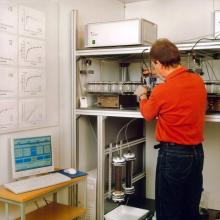Data provider
Budapest University of Technology and Economics, Department of Applied Biotechnology and Food Science, Environmental Microbiology and Biotechnology Group
Contact details
Compulsory sheet
Contaminants
- Polycyclic aromatic hydrocarbons (PAH) and other polycyclic aromatic compounds
- Other inorganic chemical compounds
- Metals, semi-metals and their compounds
Feasibility of the method
Implementation conditions
Implementation costs
Innovation, main features
LEACHING OF CONTAMINATED SOIL/WASTE USING WATER OR ARTIFICIAL RAIN-WATER. THE LEACHATE IS COLLECTED BY PUMPING. THE LEACHATE IS ANALYSED BY A CONTAMNINANT-SPECIFIC ANALITICAL METHOD.
The best reproducibility was achieved for all investigated substances in column tests. Our investigations will establish standardized and feasible laboratory procedures as fundamental for substance specific risk assessment of ontaminated sites.
Laboratory leaching tests may be used for source term determination as a basis for risk assessment for soil–groundwater pathways on contaminated sites.
1000 G HOMOGENISED (OR UNDISTURBED) SOIL SAMPLE IS FILLED INTO THE COLUMN REACTOR. THE LEACHING SOLVENT FLOWS THROUGH BY CONTINUOUS OR INTERMITTENT PUMPING FROM THE TOP TO THE BOTTOM OF THE COLUMN. LEACHATE IS COLLECTED IN 50 ML VOLUME FRACTIONS, CONTINUOUSLY. DEPENDING ON THE CONTAMINANT, CHEMICAL ANALYSES OF THE LEACHATE IS PERFORMED WITH OR WITHOUT EXTRACTION OF THE CONTAMINANT FROM THE LEACHATE. ORGANIC CONTAMINANTS ARE ANLYSED AFTER ORGANIC SOLVENT EXTRACTION BY HPLC, GC OR OTHER SEPARATION METHODS AND BY FID, MS, ETC. DETECTORS.INORGANIC CONTAMINANTS ARE ANALYSED GENERALLY BY AAS, ICP-AES, ETC.
SWOT (evalaution based on scores)
SWOT (evaluation in words)
RELATIVELY SIMPLE METHOD WITH GOOD STATISTICS, STANDARDADIZATION IS POSSIBLE.
THE APPLICATION OF SITE SPECIFIC PARAMETERS (AMOUNT AND COMPOSITION OF PRECIPITATION, ETC.) IS POSSIBLE TO ACHIVE A HIGHLY REALISTIC MODEL.
THE HIGH SURFACE-VOLUME RATIO, COMPARED TO REAL SITUATIONS MAY LOWER ENVIRONMENTAL REALITY.
IT CAN BE USED FOR ALL OF THE CONTAMINANTS WHICH ARE LEACHABLE FROM WASTES, ROCKS, TAILINGS, SOILS, SEDIMENTS, ETC.
nOT VALID INTERPRETATION OF THE RESULTS.
Other information, references
During a continuous leaching, no equilibrium is existing, similar to the real environmnet. With a batch extraction, we aim an equilibrium to increase reproducubility. In case of complex systems like solid wastes and soils an equilibrium state cannot be interpreted well.
Stefania Balzamo and Antonia Marchetti: A new standardized leaching test on stabilized wastes, Microchimica Acta, Volume 123, Numbers 1-4 / March, 1996
See also: ISO/TS 21268-4:2007 Soil quality -- Leaching procedures for subsequent chemical and ecotoxicological testing of soil and soil materials -- Part 4: Influence of pH on leaching with initial acid/base addition
BS EN 13370:2003
Characterization of waste. Analysis of eluates. Determination of Ammonium, AOX, conductivity, Hg, phenol index, TOC, easily liberatable CN^-, F^-
British-Adopted European Standard / 11-Jun-2003 / 18 pages
U. Kalbe, W. Berger, J. Eckardt and F.G. Simon: Evaluation of leaching and extraction procedures for soil and waste, Waste Management 28 (2008) 1027-1038.
Completed applications
THE CONCRETE APPLICATION DREW OUR ATTANTION TO THE SITE SPECIFICITY OF LEACHING, ETC....OR THE REMEDIATION POSSIBILITY BY THE CHANGE OF THE PH,
